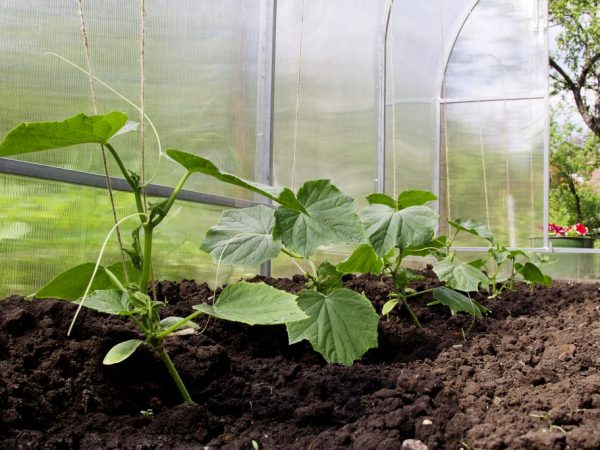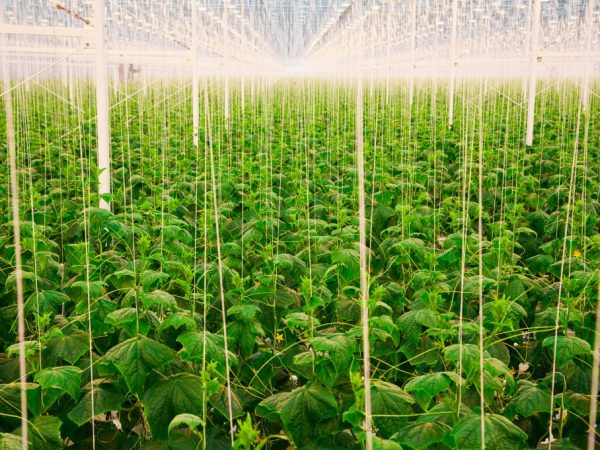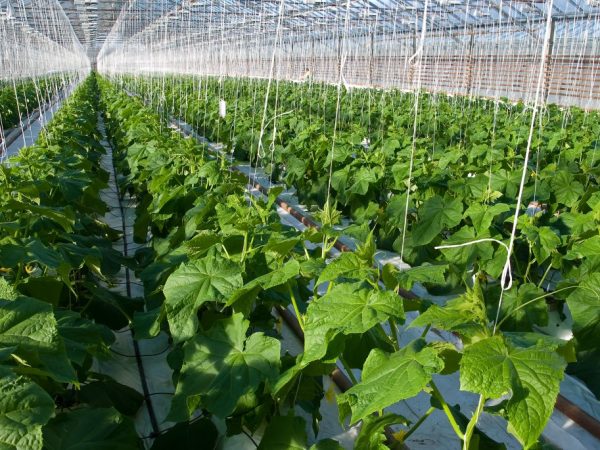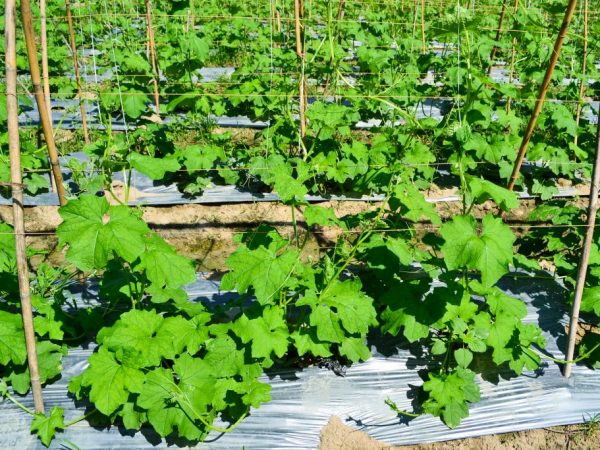Cucumber growing rules
In the article, we will tell you how cucumbers are grown, what features for caring for cucumbers exist, how to make the harvest as healthy as possible.
- Variety selection
- Seed hardening
- Soil preparation for seeds
- Transplant timing
- Transplant features
- Care advice
- Formation
- Watering cucumbers
- Top dressing
- Disease protection
- Universal remedy
- Powdery mildew control
- Pest control
- Hydroponics for growing cucumbers
- Method advantages
- The essence of the hydroponic method
- Hydroponics at home
- Gardener Tips
- Tip 1. Correctly strengthen the roots
- Tip 2. Help with pollination
- Tip 3. Increase yields
- Tip 4. Milk and cucumbers
- Tip 5. Don't forget about mulching
- Tip 6. Loosen the earth correctly
- Tip 7. Choosing neighbors

Cucumber growing rules
Variety selection
Each variety of cucumbers has its own reputation, which is based on the reviews of gardeners. Therefore, first of all, it is worth deciding on a variety, finding out its characteristics, reading reviews about it.
It is important to consider what you plan to do with the harvested crop in the future.
- Canning varieties - it is worth growing small cucumbers, on the skin of which there are pimples.
- The best varieties for salads are thornless cucumbers, which have a thin, delicate skin.
It is important to pay attention to where you plan to grow the crop. There are species that are recommended to be grown all year round in a greenhouse or in open ground.
Seed hardening
When growing cucumbers and caring for them, gardeners will never miss such an important procedure as hardening the seeds, this is necessary so that the bush does not die when the temperature fluctuates. It is not used in the seedless method of growing cucumbers.
The procedure begins with a positive temperature - 3-4 °, usually a refrigerator compartment is used for this, where they must lie for at least a day, after which they must be immediately placed in a humid environment.
Now you need to wait for the first white dots to appear, that is, the beginnings of the roots. Once this has happened, it is time to plant the seeds in a prepared container. Of course, you can use methods of growing cucumbers without hardening, but with the first frost, you risk losing the entire crop.
Soil preparation for seeds
The cucumber belongs to the pumpkin family and does not like transplants and picks. Therefore, it is worth worrying in advance that each seed has a separate container. For example, for these purposes, you can use a low-volume bucket or peat pots for sowing, the diameter of which does not exceed 6-8 cm.
It is important to create comfortable conditions for growing cucumbers, to prepare the soil for seeds. Light loosened soil is considered ideal, only so a weak cucumber sprout can hatch.
For planting, it is worth making a small depression in the center of the soil (no more than 2 cm), it is important to place the seed so that the root looks down.
Transplant timing

You can plant cucumbers in a greenhouse in May.
The time of transfer of seedlings to a permanent place of growth, that is, to a garden bed or to a greenhouse after sowing, is also important.It is recommended to stand for at least 20-25 days to allow the seedlings to grow stronger and prepare them for a more aggressive environment outside the container.
It is recommended to adhere to the following temporary recommendations:
- When planting in greenhouse conditions, it is better to choose the beginning to mid-May.
- If the cultivation of cucumbers will take place under a film cover - the second half of May.
- As for open ground, it is customary to choose the end of May - the beginning of June, when the soil in the beds has time to warm up.
Transplant features
If the sowing was successful, it's time to start the crucial stage of transferring the germinated seeds to a permanent place of growth. You already know the recommended deadlines, it's time to talk about preparing the soil in the garden beds and in the greenhouse. The future harvest depends on this.
The transplant is carried out in stages:
- Make sure that the soil layer is at least 50 cm, this is necessary so that the earth has time to warm up in the sun.
- In the fall, it is necessary to add manure to the soil, it is important to do this during this period, because by the time the seedlings are planted, the manure will have time to ferment.
- Immediately on the eve of planting, sprinkle the soil with preparations that are capable of protecting the plants that have not yet matured from parasites, including from the bear, which quite often ruins the cucumber crop.
- Do not forget to follow the temperature indicators: during the day it is recommended 20-23 °; at night - 15-17 °.
Care advice
Of course, you need to take care of vegetables at all stages, including the period of direct cultivation of cucumbers and further step-by-step grooming.
Formation
As soon as the branches of the cucumber stretch up to 20 cm, you need to start forming, for a start, you need to fix the curly vine to a trellis or similar device. It is worth saying that this recommendation concerns the cultivation of cucumbers in a heifer, in the open field it is rarely used and is considered a mistake
Watering cucumbers
Many summer residents do not know what time it is best to water cucumbers. The fact is that the plant is very fond of evening watering, when the sun sets over the horizon and is not so hot. It is worth starting with a periodicity - once every 3-4 days, however, closer to the moment the fruits appear, the number of waterings should be increased, gradually coming to daily evening watering.
Neglecting these tips can lead to unwanted bitterness in the cucumbers, which is impossible to get rid of.
Top dressing

Cucumbers can be fed once
Peat is ideal for feeding and mulching cucumbers; when choosing this material, you will free yourself from loosening the soil so as not to injure the roots once again. As soon as the roots appear from the ground, it is worth intensively adding peat or loose fertile soil.
Few people know, but there is a way to do without regular feeding and pills, for this it is important to treat the bush with Baikal Em powder one-time, which can be purchased in a specialized store. You only need half a teaspoon for each bush, as indicated in the instructions. As it dissolves, the bush will receive complete mineral nutrition with the help of root nutrition.
Disease protection
Experienced gardeners are accustomed to using folk methods of protecting and preventing cucumbers from certain diseases.
Universal remedy
For a universal spray agent you will need:
- Milk - 1 liter
- Laundry soap - 30 grams
- Iodine - 25 drops
Grate the bar of soap on the finest grater, then mix all three ingredients. The prepared solution should be sprayed on the bush once every 10-12 days, thus, it will be possible to protect it from many diseases.
Powdery mildew control
Another natural remedy will help fight this disease. To do this, you will need 1 liter of milk whey and 3 liters of warm water.
All ingredients must be mixed well, and then sprayed with diseased and healthy processes.
Pest control
To defeat pests such as ants and aphids, you can use a solution that you can also prepare yourself with your own hands, knowing some of the subtleties of the process. You will need:
- Boiling water - 2 glasses
- Wood ash - 1 glass
- Laundry soap - 20 g
As in the previous case, the vines are treated with the resulting solution by spraying. It is worth saying that using this method, you kill two birds with one stone - get rid of pests, and also feed the plant with microelements, that is, provide care and nutrition.
Hydroponics for growing cucumbers

Hydroponics has many benefits
Hydroponics or the hydroponic landless method of growing cucumbers is a common agricultural technique that helps grow good cucumbers.
Another landless farming method is growing on straw bales or alders, which can significantly save on fertilizers and irrigation.
Method advantages
- Plants grow much faster
- No soil needed
- Savings on fertilizers
- Control of power supply and photoculture is simplified
- Simplifies the fight against parasites and pests
- Refusal to use pesticides and other chemicals
The essence of the hydroponic method
The method allows you to harvest all year round, even at home, even in August, even in January.
The roots of the plant feed while not in the soil, but in a specially created air installation (in an environment with high humidity, or in a porous environment), which allows the roots to be saturated with oxygen all year round.
You can buy a ready-made hydroponicum or make it yourself from containers in accordance with the requirements of the flow chart, strictly according to the scheme. The containers are placed along the walls of the pallet, after which the resulting shoots are tied to pipes with an arc or arches. It is important to observe the correct angle of inclination of 45 °.
It is important to create such conditions for the vegetable so that daylight hours last at least 15 hours. Especially if you are growing your crop in a basement where there is no access to the sun's rays. Even if you do not grow vegetables on an industrial scale, it will be quite problematic to take them outside every day, so it is better to use lighting equipment, namely horizontal artificial lighting lamps. If hydroponics is installed in a country house or a specially equipped room, you can make a structure with wheels so that you can freely take it out to the street,
Hydroponics at home
To establish hydroponic cultivation of cucumbers at home, you should start with a drip device. To make it yourself, you will need:
- Sealed containers - 2 pcs.
- Pots in which seedlings will grow
- Pump with water
- Timer
- Irrigation tubes
- Overfill prevention device
The containers must be placed one on one, while a hole must be made in the top to protect against overflow. Excess mineral solution will come out through it.
Of course, you can purchase a ready-made structure, which will significantly save your time, but not money. It should be said that at present, this method is gaining more and more popularity, this also applies to Russia.
Gardener Tips

Tips to help you get a good harvest
In addition to the above secrets, there are a few more ideas and advice from experienced gardeners on how to grow cucumbers.
Tip 1. Correctly strengthen the roots
The rate of fruiting will directly depend on how developed the root system of the plant is. Knowing some of the rules can help the plant root better. To do this, you need to press the formed stem to the soil as much as possible, and then sprinkle with moistened soil.
Be sure to use this technique if you find that your plant is sick, such as being attacked by root rot.You just need to remove the affected whips, and then perform the above trick.
Tip 2. Help with pollination
If you are growing a bee-pollinated variety, it may happen that there are not enough insects, which will make fruiting difficult. In order for the number of ovaries to grow, you can pollinate yourself (artificially). The main thing is to do it right.
For this stage, you can use a fluffy brush to gently transfer pollen from the male flower directly to the female.
Tip 3. Increase yields
There is one feature, knowing about which, you can achieve even higher yields. Any green plant participates in the process of photosynthesis. Photosynthesis requires carbon dioxide, which is only 0.04% in the air. If you manage to increase this percentage, the yield indicator will rise accordingly.
This problem most often affects greenhouses, where the plant does not have access to air, of course, if it is not hydroponics.
To increase the carbon dioxide content, you need:
- Spread dry ice throughout the greenhouse
- Use a gas burner
- Place 2-3 containers with mullein, which will release the gas you need during fermentation
- The easiest way is probably to mulch the soil with nutritious manure 2-5 cm thick.
Tip 4. Milk and cucumbers
Milk is a nutritious food for cucumbers. Regular watering of cucumbers with milk has a positive effect on the growth rate, that is, on fruiting in general. It is important not to use undiluted milk, the recommended proportion is 1 part milk, 2 parts water.
Tip 5. Don't forget about mulching
Mulching the soil on a regular basis will loosen it up, allowing more air to enter, as well as keeping moisture and micronutrient levels longer. For this process, you can use manure, straw, peat, mineral wool, even sawdust and non-woven materials. When doing this, observe the following guidelines:
- Do not use fresh grass as mulch as this may cause rotting.
- In no case should mulch come into contact with the stem of the plant, this can also cause the development of a particular disease.
- If you use lutrasil or black film for mulch, do not forget that these materials tend to heat up at high temperatures. In this case, it is worth abandoning such mulch or using a covering material that protects the plant from overheating.
Tip 6. Loosen the earth correctly
It is necessary to loosen the earth in a special way, that is, correctly. If you notice that the soil is covered with a crust, this indicates that the plant does not receive enough oxygen, which leads to poor growth and even shedding of the ovaries.
To prevent this, you need to loosen the soil to a depth of no more than 4 cm, otherwise you can harm the roots. If the cucumber grows in peat soil, then the soil does not need to be loosened, it is enough just to pierce it with a pitchfork to ensure sufficient aeration. This also does not apply to growing in a trench.
Tip 7. Choosing neighbors
You can plant the cucumber next to peas, beans, kohlrabi, cauliflower, lettuce, celery, corn and cabbage according to the Dutch Meatlider technology.
As for corn, it must be planted from the north side.
Moreover, cucumbers will grow in the neighborhood of tansy and even quinoa, they will in no way interfere with the growth of the vegetable. The only exception is tomato; you should not plant cucumbers with this vegetable.
Now you know how to grow cucumbers, how to organize the care of cucumbers competently during cultivation, preserving the maximum yield.


